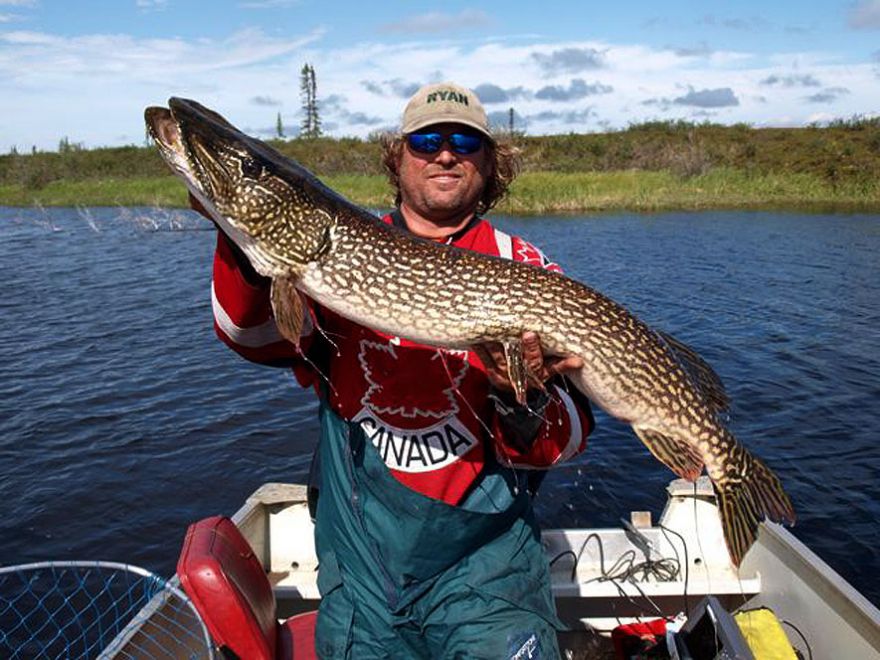Pike Heaven
![]() Written by
Harold
Written by
Harold
- Published in The Fishing
- Read 9749 times
- font size decrease font size increase font size
Heading back to the lodge after yet another day of remarkable Pike fishing on the Whitefish River, my fishing partner and I decided this was not the time to turn our backs to the wind, so we spun our seats around so we could watch the splendor of Great Bear Lake unfold in front of us, as our boat cut a path across the glass like surface of the water.
Facing into the wind can be both exhilarating yet at the same time peaceful, as the pure, sweet Arctic air envelops all of your senses, and after several minutes of contented silence, my partner leaned over and said, “If this it what heaven is like, then it’s where I want to go when my time comes.”
Under the circumstances I didn’t have the heart to suggest that it was going to take a lot more than a simple request to get him an invite upstairs, but wishful thinking notwithstanding, I knew just what he meant.
Great Bear Lake is not on most people’s radar because of the Pike fishing. The “Bear” is famous for it’s giant Lake Trout, which have been known to exceed 100 pounds, but the Pike fishery on Great Bear will hold it’s own with the likes of Trout Rock Lodge on Great Slave Lake, Esnagami Wilderness Lodge in northwestern Ontario, and other notable Pike hot spots throughout North America.

We have rarely caught less than 100 Pike on any given outing, and our 2 best single day catches were 188, and 151 fish respectively. As for size, while they usually average between 5 and 10 pounds, we have caught more than our share over 20, including one really big “gator” that tipped the scales at 32 pounds.
The places where Pike tend to congregate in numbers can be best described as transition zones. While the lake itself features deep, clear, cold and relatively unfertile water, Pike areas tend to be fairly shallow, loaded with weeds, the water is stained, and at least ten degrees warmer than what the lake has to offer.
Because of the temperature differential, it’s not uncommon to encounter patches of fog where the rivers empty into the lake. It’s as though you are entering a very different world, and I’m willing to swear that I have heard the theme music from Jaws softly playing in the background upon being enveloped by the fog on more than one occasion.
Without exception Great Bear Lake Pike have a serious attitude problem. They don’t simply hit lures, they attempt to obliterate anything you toss their way. Spoons, stick baits, buzz baits, big flies or anything else you may have lying around in your tackle box, no matter, if you offer it up they will try to kill it.
To say you would be well advised to keep your hands inside the boat at all times, is neither an exaggeration or understatement. I once dipped my boat towel into the water to give it a rinse, and ended up having a tug of war with a 5 pound Pike that came up from under the boat, and managed to get a death grip on the towel. In this case I was able to haul both towel and Pike into the boat, but if that fish had been a twenty pounder, they may have had to pull me out of the water.
Often times as soon as your lure hits the water there is swirl, followed by a splash, and then it’s game on. They will also lie in ambush until you are just about to pull your lure out of the water, and then appear seemingly out of nowhere, like some demonic apparition with the intention of pulling you, and your gear right out of the boat - perhaps never to be seen again.
The big Pike are particularly adept at this type of ambush maneuver, and my heart always beats a little faster each time I’m about to pull my lure out of the water, particularly when I know that the big boys and girls are on the hunt.
The Whitefish River is likely Great Bear’s best and most prolific Pike fishery. The river meanders across the tundra for over 90 kilometres, and empties its murky waters into the southwest corner of the Smith Arm, at the bottom end of Bydand Bay.

The furthest we have traveled upstream is about 6 kilometers, and while we caught a few fish, the majority are found within the 2 kilometer stretch upstream of the mouth, or on either side of the weed lined channel that extends approximately ½ kilometer into the main lake.
The 188 and 151 fish days were on the Whitefish, and on one of our slowest days – where we only managed to catch about 60 –the first 5 were between 20 and 32 pounds.
Other notable Pike hot spots in and around the Trophy Lodge area include both the Naiju (usually referred to as the Crockeche) and Pike Rivers. If the Whitefish River is a bit slow, give either of these two places a try, and my guess is you won't be disappointed.
Great Bear Lake is not a one trick pony. It offers multi species trophy fishing, and while Lake Trout is and will likely remain the fish of choice for most fishermen, if the Trout fishing slows down, there are plenty of trophy Grayling and Whitefish to be found in the shallows along the shoreline, or in the small creeks and streams that empty into the main lake.
On the other hand, if you would like to catch an early glimpse of what heaven just might be like – for Pike fisherman anyway – just amble on over to the Smith Arm and see for yourself.









